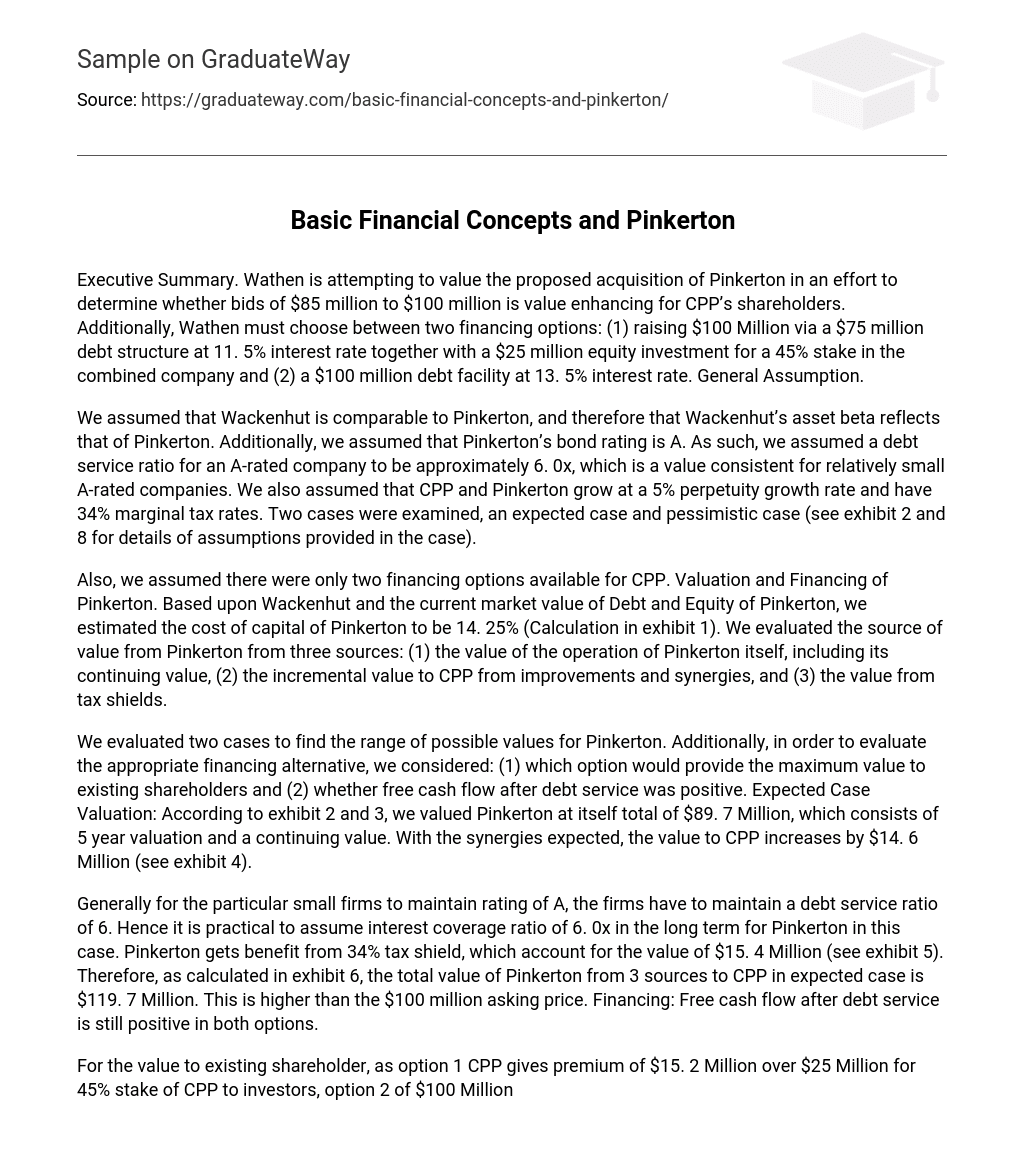Executive Summary. Wathen is attempting to value the proposed acquisition of Pinkerton in an effort to determine whether bids of $85 million to $100 million is value enhancing for CPP’s shareholders. Additionally, Wathen must choose between two financing options: (1) raising $100 Million via a $75 million debt structure at 11. 5% interest rate together with a $25 million equity investment for a 45% stake in the combined company and (2) a $100 million debt facility at 13. 5% interest rate. General Assumption.
We assumed that Wackenhut is comparable to Pinkerton, and therefore that Wackenhut’s asset beta reflects that of Pinkerton. Additionally, we assumed that Pinkerton’s bond rating is A. As such, we assumed a debt service ratio for an A-rated company to be approximately 6. 0x, which is a value consistent for relatively small A-rated companies. We also assumed that CPP and Pinkerton grow at a 5% perpetuity growth rate and have 34% marginal tax rates. Two cases were examined, an expected case and pessimistic case (see exhibit 2 and 8 for details of assumptions provided in the case).
Also, we assumed there were only two financing options available for CPP. Valuation and Financing of Pinkerton. Based upon Wackenhut and the current market value of Debt and Equity of Pinkerton, we estimated the cost of capital of Pinkerton to be 14. 25% (Calculation in exhibit 1). We evaluated the source of value from Pinkerton from three sources: (1) the value of the operation of Pinkerton itself, including its continuing value, (2) the incremental value to CPP from improvements and synergies, and (3) the value from tax shields.
We evaluated two cases to find the range of possible values for Pinkerton. Additionally, in order to evaluate the appropriate financing alternative, we considered: (1) which option would provide the maximum value to existing shareholders and (2) whether free cash flow after debt service was positive. Expected Case Valuation: According to exhibit 2 and 3, we valued Pinkerton at itself total of $89. 7 Million, which consists of 5 year valuation and a continuing value. With the synergies expected, the value to CPP increases by $14. 6 Million (see exhibit 4).
Generally for the particular small firms to maintain rating of A, the firms have to maintain a debt service ratio of 6. Hence it is practical to assume interest coverage ratio of 6. 0x in the long term for Pinkerton in this case. Pinkerton gets benefit from 34% tax shield, which account for the value of $15. 4 Million (see exhibit 5). Therefore, as calculated in exhibit 6, the total value of Pinkerton from 3 sources to CPP in expected case is $119. 7 Million. This is higher than the $100 million asking price. Financing: Free cash flow after debt service is still positive in both options.
For the value to existing shareholder, as option 1 CPP gives premium of $15. 2 Million over $25 Million for 45% stake of CPP to investors, option 2 of $100 Million Debt would be more preferable. Pessimistic Case Valuation: We then perform the valuation exactly the same method as expected case. The value of Pinkerton with less gross margin and more working capital needed is $67. 1 Million (See exhibit 9 for 5 years valuation and exhibit 10 for terminal value). With lower performance, the value of 34% tax shield is also lower to $10. Million (see exhibit 12). Without any additional incremental value to CPP (exhibit 11), total Pinkerton value from 3 sources is $77. 9 Million (exhibit 13), which is even less than the original proposed value of $85 Million from Wathen. Financing: Free cash flow after debt service is still positive in both options even though it runs very close to negative levels in option 2 in year 4 and 5. This implies that anything worst than pessimistic case would lead to a financing inability for CPP, and hence increasing the likelihood of financial distress.
In terms of value to existing shareholders in option 1, investors receive negative premium for 45% of CPP stakes. Thus, the value to existing shareholders is higher when financing with $75 Million debt, and therefore is more preferable choice of financing. Recommendation for CPP. CPP needs to justify which case is more likely to occur in order to determine the appropriate value for Pinkerton. Given that CPP is an expert in security guard business, there should be larger chance that CPP will be able to improve Pinkerton performance and create value for CPP.
Given that we agree that the expected case is more likely than the pessimistic case, we believe that Pinkerton will be worth the $100 million asking price. With the conclusion that expected case is more appropriate to value Pinkerton, we recommend that CPP choose to finance $100 million with all debt. Exhibit 1: Cost of Equity Exhibit 2: Expected Case: 5 Year Valuation Exhibit 3: Expected Case: Terminal Value Exhibit 4: Expected Case: Value Creation to CPP Exhibit 5: Expected Case: Value from Tax Shield [pic] Exhibit 6: Expected Case: Total Value of Pinkerton pic] Exhibit 7: Expected Case: Financing with $75M Debt [pic] Exhibit 8: Expected Case: Financing with $100M Debt [pic] Exhibit 9: Pessimistic Case: 5 Years Valuation [pic] Exhibit 10: Pessimistic Case: Terminal Value Exhibit 11: Pessimistic Case: Value Improvement to CPP [pic] Exhibit 12: Pessimistic Case: Value of Tax Shield [pic] Exhibit 13: Pessimistic Case: Total Value of Pinkerton [pic] Exhibit 14: Pessimistic Case: Financing with $75 Million Debt [pic] Exhibit 15: Pessimistic Case: Financing with $100 Million Debt [pic]





